I have UIView which I need to draw a border only partial part view, how do I do in using UIBezierPath
Asked
Active
Viewed 944 times
0
Ram
- 269
- 2
- 9
-
check this out https://stackoverflow.com/questions/36836367/how-can-i-do-programmatically-gradient-border-color-uibutton-with-swift – Hammer Class Aug 21 '20 at 12:50
2 Answers
2
If you want to use UIBezierPath, you could choose the "silly" way:
- stroke the full border of your view
- "cover up" the part where you don't want the border to exist with the view's background color, by drawing a rectangle on top of the border.
class MyView: UIView {
override init(frame: CGRect) {
super.init(frame: frame)
commonInit()
}
required init?(coder: NSCoder) {
super.init(coder: coder)
commonInit()
}
private func commonInit() {
layer.cornerRadius = 3
backgroundColor = .white
layer.masksToBounds = true
}
override func draw(_ rect: CGRect) {
let borderPath = UIBezierPath(roundedRect: bounds, cornerRadius: 3)
borderPath.lineWidth = 7
UIColor.gray.setStroke()
borderPath.stroke()
let covering = UIBezierPath(rect: CGRect(x: 20, y: -10, width: self.bounds.width - 40, height: 20))
backgroundColor?.setFill()
covering.fill()
}
}
Output:
Other than that, I can't think of an easy way to do this.
However, if you can use CAShapeLayer...
You should set the strokeEnd and strokeStart properties of a CAShapeLayer added as a sublayer of your view's layer.
Example:
class MyView: UIView {
override init(frame: CGRect) {
super.init(frame: frame)
commonInit()
}
required init?(coder: NSCoder) {
super.init(coder: coder)
commonInit()
}
private func commonInit() {
layer.cornerRadius = 3
let border = CAShapeLayer()
// make sure this path coincides with the border of the view
border.path = UIBezierPath(roundedRect: bounds, cornerRadius: 3).cgPath
// you should tweak these numbers
border.strokeStart = 0.3
border.strokeEnd = 0.7
border.strokeColor = UIColor.gray.cgColor
border.lineWidth = 3
border.fillColor = nil
layer.addSublayer(border)
backgroundColor = .white
}
}
Output:
Sweeper
- 213,210
- 22
- 193
- 313
2
I did exactly the same thing but animated once, to mimic android materials textfield design and behavior in ios app here is the shape creation code:
placeholderWidth is size of gap on top, leftInset is inset from frame left corner
class FloatingTextfieldBorderShapeCreator {
var leftInset: CGFloat
init(leftInset: CGFloat) {
self.leftInset = leftInset
}
func create(frame: CGRect, placeholderWidth: CGFloat) -> CGPath {
let path = UIBezierPath()
let arcRadius: CGFloat = 4.0
//1. starting point top left
let startingPoint = CGPoint(x: frame.minX + leftInset - 4, y: frame.minY)
path.move(to: startingPoint)
//2. top left arc
let topLeftArcCenter = CGPoint(x: frame.minX + arcRadius, y: arcRadius)
path.addArc(withCenter: topLeftArcCenter, radius: arcRadius, startAngle: 3*CGFloat.pi/2, endAngle: CGFloat.pi, clockwise: false)
//3. left line
let leftLineEndPoint = CGPoint(x: frame.minX, y: frame.height - arcRadius)
path.addLine(to: leftLineEndPoint)
//4. bottom left arc
let bottomLeftArcCenter = CGPoint(x: frame.minX + arcRadius, y: frame.height - arcRadius)
path.addArc(withCenter: bottomLeftArcCenter, radius: arcRadius, startAngle: CGFloat.pi, endAngle: CGFloat.pi/2, clockwise: false)
//5. bottom line
let bottomLineEndPoint = CGPoint(x: frame.width - arcRadius, y: frame.height)
path.addLine(to: bottomLineEndPoint)
//6. bottom right arc
let bottomRightArcCenter = CGPoint(x: frame.width - arcRadius, y: frame.height - arcRadius)
path.addArc(withCenter: bottomRightArcCenter, radius: arcRadius, startAngle: CGFloat.pi/2, endAngle: 0, clockwise: false)
//7. right line
let rightLineEndPoint = CGPoint(x: frame.width, y: frame.minY + arcRadius)
path.addLine(to: rightLineEndPoint)
//8. top right arc
let topRightArcCenter = CGPoint(x: frame.width - arcRadius, y: frame.minY + arcRadius)
path.addArc(withCenter: topRightArcCenter, radius: arcRadius, startAngle: 0, endAngle: -CGFloat.pi/2, clockwise: false)
//9. top line
let topLineEndPointX = startingPoint.x + placeholderWidth
let topLineEndPoint = CGPoint(x: topLineEndPointX, y: frame.minY)
path.addLine(to: topLineEndPoint)
return path.cgPath
}
}
and properties to apply on drawing layer:
borderLayer.frame = borderFrame
borderLayer.fillColor = nil
borderLayer.lineWidth = 1.0
borderLayer.strokeColor = .lightGray
Robert Juz
- 126
- 7

